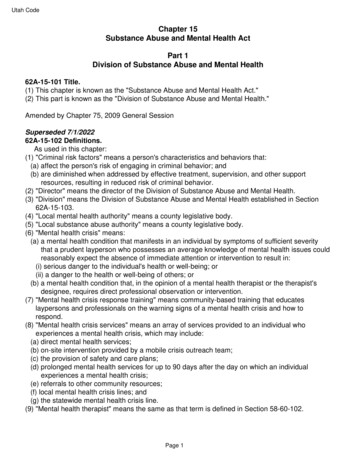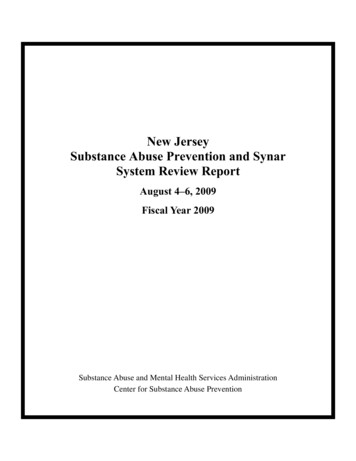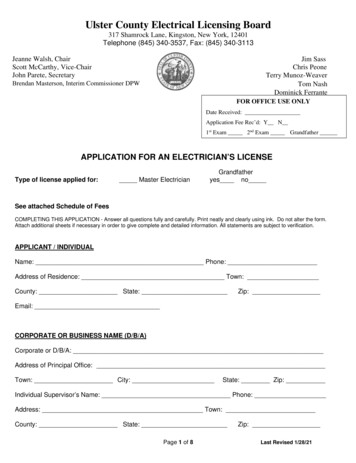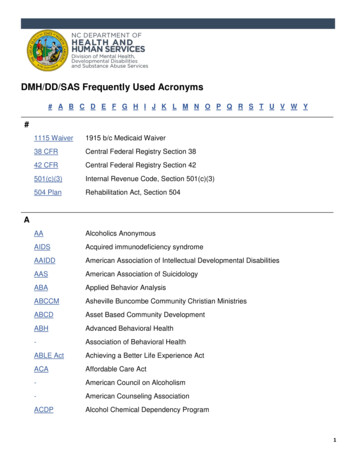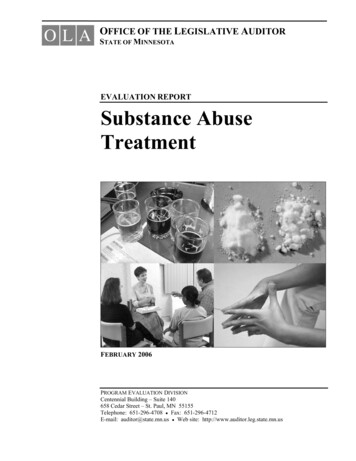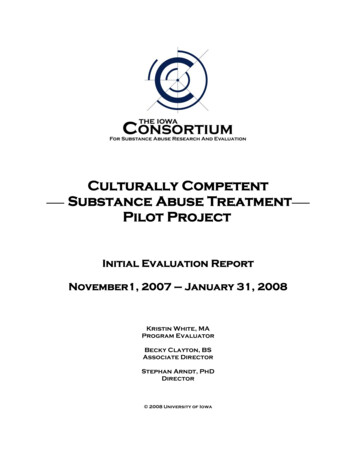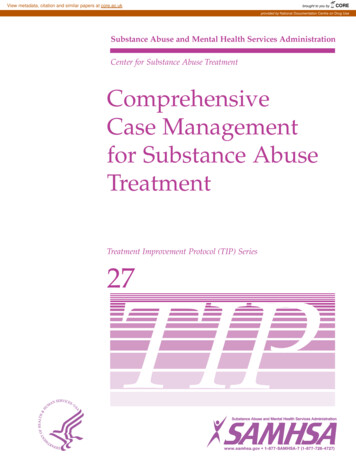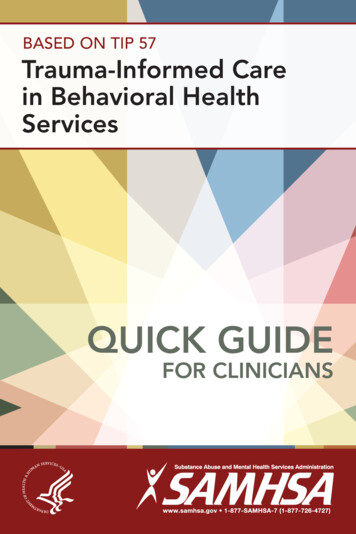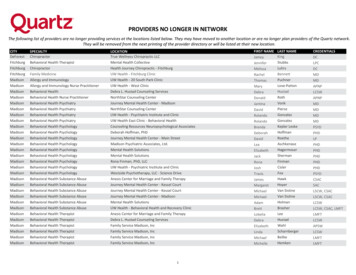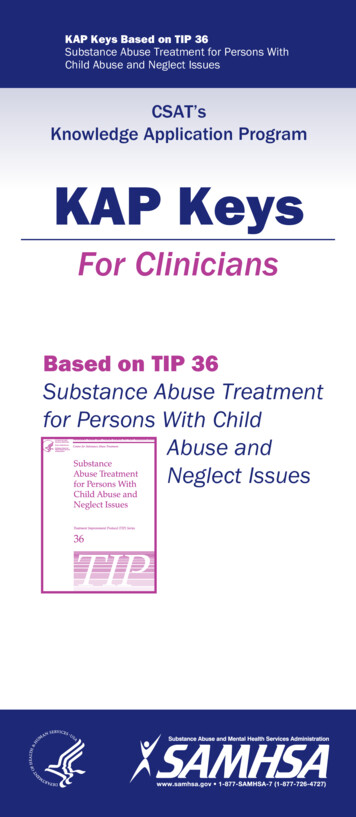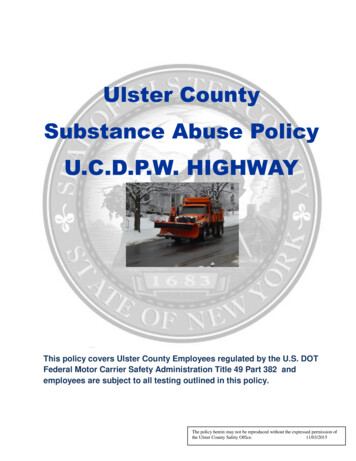
Transcription
Ulster CountySubstance Abuse PolicyU.C.D.P.W. HIGHWAYThis policy covers Ulster County Employees regulated by the U.S. DOTFederal Motor Carrier Safety Administration Title 49 Part 382 andemployees are subject to all testing outlined in this policy.The policy herein may not be reproduced without the expressed permission ofthe Ulster County Safety Office.11/03/2015
Ulster County Substance Abuse PolicyPurpose / Policy Applicability / Testing Procedures/ Employee Responsibility . 2Background / Definitions . . 3 - 5Responsibilities 6Drug and Alcohol Testing / Pre-employment and Random Testing . . 7 - 8Post-Accident Testing 9-10Reasonable Cause / Suspicion Testing . . 11 - 12Return-to-Duty Testing and Follow-up Testing . 12 - 13Review of Drug Testing Results and Consequences. . 13-15Retention of Specimens / Record-keeping Procedures .15Substance Abuse Policy Personnel and Services 16Appendix A . 17(Employee Receipt of Ulster County Substance Abuse Policy)Appendix B . 18 - 19(Reasonable Cause / Suspicion Testing Evaluation Form)Appendix C . 20 - 24(Memorandum of Agreement)1
PurposeThe purpose of the Ulster County Substance Abuse Policy is to establish rules, regulations and programs toensure that the Ulster County workplace and its employees are free from the detrimental effects of drugs andalcohol. The Policy is in compliance with the mandates contained in Title 49 Code of Federal Regulations(CFR) Part 40 (Testing Procedures) and Title 49 CFR Part 382 (U.C. DOT Federal Highway Administration)and other applicable laws, rules, and regulations.Policy ApplicabilityUlster County Department of Public Works full-time employees, part-time employees and volunteerswho:1) are required to hold a CDL (Commercial Driver’s License) for use in the performance oftheir job;They shall be subjected to all types of testing as outlined in Title 49 Part 382, (Pre-employment / Preassignment, Random, Post-accident, Reasonable Cause / Suspicion, Return-to-Duty and Follow-up).Any new positions created will be reviewed using the criteria above and if meeting the criteria, theywill be added to the list subjected to all testing under Title 49 Part 382.All Ulster County employees who are CSEA bargaining unit members and non-union managementpositions are subject to “Reasonable Cause / Suspicion” testing, as outlined under Reasonable Cause/Suspicion testing in this policy.Testing ProceduresAll testing procedures will be conducted pursuant to Title 49 Part 40, Procedures for Transportation WorkplaceDrug and Alcohol testing. All testing analysis shall be performed at a federally certified laboratory.Sample specimens shall be collected by a contracted agency following Title 49 Part 40 and all randomselection will be conducted by the contracted agency utilizing software for random selection, ex. Randomware,JJKeller, etc. No random selection shall be made internally by Ulster County.Employee ResponsibilityEach employee must be knowledgeable of and fully comply with the requirements of this policy.An employee must notify their supervisor of any drug related criminal arrest immediately and of any convictionwithin five days thereafter.Any employee who takes any drug prescribed by a licensed physician, any self-prescribed substance, or asubstance for any therapeutic use, must notify his / her supervisor when such use may impact the employee’sability to perform his / her duties so that they may be removed from any safety sensitive function.Prohibited Drug and AlcoholNo employee shall use, sell, possess, distribute, or manufacture any alcoholic beverage or illegal drug or anyother intoxicating substance at any time on County property, while on duty; or in a County vehicle, a vehicleleased for County business, or a privately owned vehicle being used for County business during theemployees work hours.2
Prohibited Drug and Alcohol – continuedNo employee shall report to work at the beginning of a shift or upon returning from any break, lunch or restperiod under the influence of alcohol, illegal drugs or other intoxicating substance.No employee shall possess alcohol during work hours, perform any duties of his/her job with Ulster Countywithin four (4) hours after using alcohol or for eight (8) hours following an accident (as defined in this Policy) oruntil he/she undergoes a Post-accident alcohol test. (All County Employees)This Ulster County Substance Abuse Policy supersedes any other policies and procedures pertaining toalcohol and prohibited substances, as they pertain to Ulster County employee’s that are CSEA Bargaining UnitMembers and Non-Union Management employees.BackgroundThe catalyst for this Ulster County Substance Abuse Policy is Title 49 CFR Part 382 which requires employersto test their employees who maintain a Commercial Drivers License (CDL) in the performance of their dutiesfor prohibited drugs and alcohol under the following work-related conditions:a)b)c)d)e)f)Pre-employment / Pre-assignmentPost-accidentRandomReasonable cause / SuspicionReturn-to-DutyFollow-upDefinitionsFor purposes of this Ulster County Substance Abuse Policy the following definitions apply:Alcohol – The intoxicating agent in beverage alcohol, ethyl alcohol, or other low molecular weight alcoholincluding methyl and isopropyl alcohol.Alcohol Concentration – (or content) The alcohol in a volume of breath expressed in terms of grams ofalcohol per 210 liters of breath as indicated by an evidential breath test.Alcohol Screening Test – An analytic procedure to determine whether an employee may have a prohibitedconcentration of alcohol in his/her blood, as indicated by a reading of a breath or saliva specimen.Alcohol Use – means the drinking or swallowing of any beverage, liquid mixture or preparation (including anymedication), containing alcohol.Assistant Substance Abuse Program Manager (ASAPM) – Person responsible for the preparation andadministration of this Policy.Blind Specimen or Blind Performance Test Specimen – A specimen submitted to a laboratory for qualitycontrol testing purposes, with a fictitious identifier, so that the laboratory cannot distinguish it from anemployee specimen.Breath Alcohol Technician (BAT) – A person who administers, instructs and assists employees in thealcohol testing process and operates an evidential breath-testing device.Chain of Custody – The procedure used to document the handling of an employee’s urine specimen from thetime of collection until the specimen is destroyed. This procedure uses the Federal Drug Testing Custody andControl Form. (CCF), Title 49 CFR Part 40.3
Collection Site – A place selected by the employer where employees present themselves for the purpose ofproviding a urine specimen for a drug/alcohol test.Confirmatory Alcohol Test – For alcohol testing, this is defined as a second test, following a screening testthat provides quantitative data of alcohol concentration, resulting in a reading of 0.02 BAC or greater. If theresults of the initial alcohol screening result differ from the confirmation test, the value of the confirmation testshall be the final result.Confirmatory Drug Test – A second analytical procedure used to identify the presence of a specific drug ormetabolite, which is independent of the initial test and which uses a different technique and chemical principlefrom that of the initial test. (Gas chromatography / mass spectrometry (GC/MS) is the only authorizedconfirmation method for cocaine, marijuana, opiates, amphetamines, and phencyclidine).Covered Employee – It is the County’s policy that an employee of the Ulster County Department of PublicWorks (UCDPW) who’s job title and description requires the employee to have a CDL license, along with alldrivers covered under Title 49 Part 382 shall be tested by the different types of tests outlined in the policy.(Pre-employment, Pre-assignment, Random, Post-accident, Reasonable Cause / Suspicion, Return-to-Dutyand Follow-up testing).Cut Off Levels – The minimum value established for designating a test result as positive. These levels are setby the Department of Health and Human Services (Federal).Dilute Specimen - A urine specimen with creatinine and specific gravity values that are lower than expectedfor human urine.Drugs Prohibited – Alcohol, Amphetamines, Cocaine, Ecstasy, Heroin, Marijuana, Opiates, andPhencyclidine.Employee Assistance Program (EAP) – Ulster County provides all employees with a means of obtainingconfidential professional assistance in handling personal problems, which may adversely affect jobperformance. EAP shall function as a means to provide a Substance Abuse Professional (SAP).Evidential Breath Testing Device (EBT) – A device approved by National Highway Traffic SafetyAdministration (NHTSA) for the evidential testing of breath.Fail an Alcohol Test or Test Positive – A confirmation test for alcohol that shows the presence of alcohol inthe employee’s specimen of 0.02 BAC or greater.Fail a Drug Test or Test Positive – A confirmation test result shows the presence of drug metabolites in theemployee’s / applicants specimen over the established cut-off levels detailed in Title 49 CFR Part 40.Federal Motor Carrier Safety Administration (FMCSA) – federal governing agency for Title 49 Part 382.Initial Drug or Alcohol Test (also known as a Screening test) – In a drug-screening test it is animmunoassay test to eliminate “negative” urine specimens from further consideration and to identify thepresumptively positive specimens that require confirmation or further testing. In an alcohol screening test itmeans an analytical procedure to determine whether an employee may have a prohibited concentration ofalcohol in his or her system.Medical Review Officer (MRO) – A licensed physician (medical doctor or doctor of osteopathy) responsiblefor receiving laboratory results generated by an employer’s drug testing program who has knowledge ofsubstance abuse disorders and has appropriate medical training to interpret and evaluate an individual’sconfirmed positive test result together with his/her medical history and any other biomedical information.Pass an Alcohol Test or Test Negative – A result less than 0.02 BAC in an alcohol-screening test.4
Pass a Drug Test or Test Negative – A result where the initial testing and/or confirmation testing does notshow evidence of any prohibited drug metabolites above the established cut-off levels in the employee orapplicant’s system.Oxidizing Adulterant - A substance that acts alone or in combination with other substances to oxidize drugsor drug metabolites to prevent their detection. It affects the reagents in either the initial or confirmatory drugtest.Refusal to Submit (to an alcohol or controlled substances test) – An employee will be deemed to haverefused to take a drug test, which will result in an automatic positive, if the employee:(1) Failed to appear at the collections site for any test (except a pre-employment test) immediately orwithin 30 minutes, plus travel time dependent on work location.(2) Fails to remain at the testing site until the testing process is complete.(3) Fails to provide a urine specimen for any drug or alcohol test requested under this policy and/orapplicable regulations.(4) In the case of a directly observed or monitored collection in a drug test, the employee’s failure topermit the observation or monitoring of his/her provision of a specimen.(5) Fails to provide a sufficient amount of urine when directed and it has been determined, through arequired medical evaluation, that there was no adequate medical explanation for the failure.(6) Fails or declines to take an additional drug test the employer or collector has directed theemployee to take.(7) Fails to undergo a medical examination or evaluation as part of the verification process, asdirected by the MRO, the SAPM or ASAPM.(8) Fails to cooperate with any part of the testing process (e.g., refuses to empty pockets whendirected by the collector, behaves in a confrontational way that disrupts the collection process,fails to wash hands after being directed to do so by the collector).(9) For an observed collection, fails to follow the observer’s instructions to raise employee’s clothingabove the waist, lower clothing and underpants, and to turn around to permit the observer todetermine if the employee has any type of prosthetic or other device that could be used tointerfere with the collection process.(10) Possesses or wears a prosthetic or other device that could be used to interfere with the collectionprocess.As an employee who refuses to take a drug or alcohol test, he or she shall incur theconsequences of a positive test under this Policy.Substance Abuse Program Manager (SAPM) – Individual who is responsible for the preparation andadministration of this Policy.Split Specimen – In drug testing, a part of the urine specimen that is retained unopened, sent to a firstlaboratory and transported to a second laboratory in the event that the employee requests that it be testedfollowing a verified positive test of a primary specimen or a verified adulterated or substituted test result.Substance Abuse Professional (SAP) – A licensed physician (Medical Doctor or Doctor of Osteopathy), or alicensed or certified psychologist, social worker, employee assistance professional, or addiction counselor(certified by the National Association of Alcoholism and Drug Abuse Counselors Certification Commission)who has knowledge of alcohol and controlled substance related disorders.Verified Test – A drug test result or validity testing result from a certified laboratory that has undergone reviewand received a final determination by the MRO.5
ResponsibilitiesSubstance Abuse Program Manager (SAPM) and Assistant Manager (ASAPM) – The SAPM / ASAPMshall be responsible for the administration of the testing program described in this Policy, which complies withTitle 49 CFR Part 40, including the scheduling of all drug and alcohol testing associated with this policy. TheSAPM/ASAPM shall be responsible for oversight and evaluation of the policy, including the provision ofguidance and counseling to employees. This individual shall also review all disciplinary actions applied underthe policy for consistency and conformance to applicable local, state, and federal policies and procedures. TheSAPM/ASAPM shall also maintain a secure file system on the test results, keep all necessary records, andoversee the Employee Assistance Program (EAP) as it relates to this policy.Medical Review Officer (MRO) – The MRO shall review the laboratory results to verify and validate testsadministered under this policy. This individual shall be a licensed physician who has knowledge of substanceabuse disorders and the appropriate medical training to interpret and evaluate an employee’s confirmedpositive test result together with his or her medical history and any relevant biomedical information. The MROshall follow all procedures set forth in Title 49 CFR Part 40, as amended. The MRO shall not be an employeeof the laboratory conducting the drug test unless the laboratory establishes a clear separation of functions, inorder to prevent any appearance of a conflict of interest, including providing assurance that the MRO has noresponsibility for, and is not supervised by or the supervisor of, any persons who have responsibility for thedrug testing or quality control operations of the laboratory. The MRO shall review all medical records madeavailable by the tested employee when it is alleged that a confirmed positive test could have resulted from alegally prescribed medication. The MRO shall not disclose to any third party medical information provided bythe employee to the MRO as a part of the testing verification process. This review shall be performed by theMRO prior to the transmission of results to the SAPM or ASAPM. The duties of the MRO with respect tonegative results are purely administrative.Substance Abuse Professional (SAP) – The SAP may be a licensed physician (Medical Doctor or Doctor ofOsteopathy), or a licensed or certified psychologist, social worker, or employee assistance professional, whohas knowledge of and clinical experience with the diagnosis and treatment of drug and alcohol relateddisorders, or an addiction counselor certified by the National Association of Alcoholism and Drug AbuseCounselors Certification Commission. The SAP shall evaluate any employee who may have refused to submitto a drug or alcohol test or who has received a verified positive drug or alcohol test and as such, requiresassistance in addressing problems associated with prohibited drug and alcohol use. The SAP shall evaluatean employee who has a verified positive drug or alcohol test result if he or she has complied with the SAPrecommendations. The SAP shall determine when return-to-duty testing is appropriate. The SAP shall set thelength and schedule of testing, a minimum of six (6) tests during the first twelve (12) months, which maycontinue for a period up to five (5) years or sixty (60) months after returning to duty. The SAP may not referthe employee to the SAP’s private practice from which the SAP receives remuneration or to a person ororganization in which the SAP has a financial interest. The SAP shall follow the procedures and regulations asset forth in Title 49 CFR Part 40.Supervisors – Those supervisors that have been specifically trained to and are responsible for theobservation of employee’s performance and behavior. Supervisors shall document events which suggest theappropriateness of reasonable cause testing. When applicable, Supervisors shall request that a secondsupervisor substantiate and concur that reasonable cause testing is warranted under the circumstancespresented. A final determination of testing is made by the Substance Abuse Program Manager orAssistant Manager.6
Drug and Alcohol TestingEmployees Subject to Drug and Alcohol Testing: All employees of Ulster County who are members of theCivil Service Employees Association, Inc., Local 1000, AFSCME, AFL-CIO, Ulster County Unit # 8950 or nonrepresented management are subject to drug and alcohol testing.1) Procedure for Notifying Employees:All employee members of the Ulster County Civil Service Employees Association (Unit 8950) and nonrepresented management shall receive a copy of the Ulster County Substance Abuse Policy and shallbe held responsible for knowing and abiding by the content of this policy. Each employee subject to thepolicy shall sign a form acknowledging receipt of and agreeing to abide by this policy (Appendix A). Anyrequest for clarification or question regarding the content of this policy shall be directed to the SAPM orASAPM. All newly hired employees shall receive a copy of the policy and shall review the policy withthe SAPM or ASAPM on the day of his/her orientation with Ulster County.2) Substances for Which Testing Shall Be Conducted:The cutoff levels for detecting these drugs / alcohol are as follows:Drug NameInitial Cut-off Levels (ng/ml)AlcoholAmphetaminesCocaine metabolitesMarijuana metabolitesOpiates – Morphine / CodeinePCP – Phencyclidine0.02 (gr/lt)1000 (ng/ml)300 (ng/ml)50 (ng/ml)2000 (ng/ml)25 (ng/ml)Confirmatory Cut-off Levels (ng/ml)0.02 (gr/lt)500 (ng/ml)150 (ng/ml)15 (ng/ml)2000 (ng/ml)25 (ng/ml)(Heroin and Ecstasy are identified in a confirmatory result)1. Pre-employment / Pre–assignment – A pre-employment drug and alcohol test shall be performed and anegative test result received, before an individual is offered employment with the Ulster County Department ofPublic Works (all positions which require a CDL license for the performance of job duties). A pre-assignmenttest shall be performed and a negative test result received before an employee who has been out on a leaveof absence, or a medical disability, or absent from work 30 days or more for any reason and removed from therandom pool.2. Random Testing – All employees whose positions are covered under the Federal Motor Carrier SafetyAdministration shall be subject to drug and alcohol testing on an unannounced and random basis. The Countyshall conduct a number of drug tests on these employees equal to at least fifty (50) percent of the averagenumber of covered employees each calendar year, spread reasonably over a twelve (12) month period. Inaddition, the County shall conduct a number of alcohol tests on these employees equal to at least ten (10)percent of the number of such covered employees each calendar year, spread reasonably over a twelve (12)month period. These rates will be reviewed annually and may be adjusted. (Ulster County adheres to thepercentage that is more stringent of the two percentages set by the Federal Transit Administration and FederalHighway Administration as current)The following is an outline of the key aspects of the random testing selection process.a) Employees shall be selected for testing using a computer-based random number generatoror equivalent random selection method owned/licensed and operated by the testing site.The numbers generated on the random basis will then be matched with a coveredemployees social security number or County employee number.b) Employees shall remain in the random selection pool at all times regardless of whether ornot they have been previously selected for testing.c) The testing and collection process will be unannounced as well as random. Employees willbe notified that they have been selected for testing after they have reported for duty on theday of collection. The time may be at any time the covered employee is working.7
2. Random Testing- continuedd) Employees will be selected for random testing based on the number of covered employeesat the time and the necessary testing rate.e) Specimen collection shall be conducted on different days of the week throughout the annualcycle.f) The SAPM or ASAPM, on a pre-determined date, shall use the random selectionprocedures to compile a list of covered employees selected for random testing during thattesting cycle.g) On the day of the test, the appropriate supervisor shall be contacted with the coveredemployees’ names provided by the random selection process. Once the supervisor notifiesthe covered employee that he / she has been chosen for the random testing, he / she shallreport immediately to the collection site or within 30 minutes, plus travel time dependent onwork location.h) If an employee, once directed to report for testing, refuses or fails to appear at the collectionsite within the allotted time, this shall be considered a “refusal to test”, and will be treatedunder the policy as a positive test result.i) Upon arrival at the collection site, the employee shall identify him / herself to the collectionsite personnel by presenting photo identification (i.e. County photo identification, or driver’slicense).j) The employee shall provide his / her urine specimen as directed, and, if applicable, a breathsample, in accordance with the procedures set forth in CFR Title 49 Part 40.k) Upon receipt of a documented, formal, written request for a covered employee’s test result,made to the SAPM or ASAPM, that employee shall be furnished with a copy of his/her testresult.l) Random testing shall include drug test screening for alcohol, amphetamines, cocainemetabolites, ecstasy, heroin, marijuana metabolites, opiates – morphine / codeine, and PCPphencyclidine.8
3. Post-Accident Testing – The following are the guidelines for post-accident testing of an employee(s)covered by the Federal Motor Carrier Safety Administration (FMCSA). The term “Post-Accident Testing” andits determined guidelines for testing are listed below, they apply to employees who utilize a CDL driver’slicense in the performance of their job or perform an identified safety sensitive job.If an accident involves the operation of a Commercial Motor Vehicle governed by the FMCSA and the specificsof the accident fall within the parameters for testing below, an employee involved in such accident shall bedrug tested as soon as possible but no later than thirty-two (32) hours after the accident. Alcohol testing shallbe performed as soon as possible, but no later than eight (8) hours after the accident occurs.The following procedure involving post-accident testing shall be followed:1.2.The employee involved in the accident must immediately notify the shift supervisor.A supervisor shall be dispatched to the scene of the accident. They will evaluate the accidentagainst the policy parameters to test under post- accident. If a test is warranted or if they are notsure, the supervisor may contact the SAPM or ASAPM.3.Policy parameters for post-accident testing:a. Fatality - If there is a fatality in the accident, in either vehicle or a pedestrian has beenkilled, the driver shall be tested. Any covered employee whose performance may havecontributed to the accident shall also be tested, they shall be tested for alcohol and drugs,or;b. The driver receives a citation within 8 hours (alcohol testing) or within 32 hours (drugtesting) of the occurrence under State or local law for a moving traffic violation arisingfrom the accident, if the accident involved:i. Bodily injury to any person who, as a result of the injury, immediately receivesmedical treatment away from the scene of the accident; orii. One or more motor vehicles incurring disabling damage as a result of theaccident, requiring the motor vehicle to be transported away from the scene by atow truck or other motor vehicle.4.A supervisor finding that the accident meets the parameters above shall contact the SAPM orASAPM immediately so that a test may be setup.5.When the supervisor makes contact with the SAPM or ASAPM, together they will arrangetransport of the driver or employee involved to the testing site.6.When the testing is complete, arrangements to transport the employee to their residence will bemade. The employee shall not drive his or her vehicle home, for the employee maybe under theinfluence of alcohol or a controlled substance. They shall be told that they will have to pick uptheir vehicle at a later time.7.The employee shall be placed on paid administrative leave pending the result of the test. Theywill only be paid for their scheduled days of work they are being held from.8.The result of the test shall dictate the next step, either return to work or be subject to theconsequences of a positive test.9
Post-Accident Testing - continuedAn accident where our driver or employee has been injured:1.If the employee is being treated at the hospital as a result of the accident, the supervisor shallcontact the SAPM or ASAPM to inform him/her of the situation. When medical treatment allows,drug and/or alcohol testing shall be performed at the hospital or the collection site within thetimeframe generally allotted for testing under this policy. Alcohol testing shall occur first. If analcohol test is not administered within two (2) hours following the accident, documentation mustbe provided by the supervisor to the SAPM or ASAPM and maintained on file, stating thereasons why the test was not promptly administered. If the employee has not been tested withineight (8) hours following the accident, all attempts to test for alcohol must cease. If an alcoholtest is not performed, the supervisor shall prepare and produce documentation to be given to theSAPM or ASAPM for the file, stating the reasons why the test was not performed. If an initialalcohol test results in a reading of 0.02 BAC or greater, a confirmatory test shall take place nomore than thirty (30) minutes after the initial test. If the confirmation test is greater than 0.02BAC, the BAT must notify the SAPM or ASAPM immediately. The SAPM or ASAPM will thennotify the supervisor of the test results. Urine collection for the drug test shall be performedwithin 32 hours.2.After testing is completed, the employee will not be allowed to return to his / her position until anegative test result is received by the SAPM or ASAPM. The employee shall be placed on paidadministrative leave pending the result of the test and only be paid for the days they had beenscheduled to work but were held out pending the results of the test.3.The employer shall also drug and alcohol test any other covered employee whoseperformance could have contributed to the accident, as determined by the employerusing the best information available at the time of the decision.Any employee who is involved in an accident that triggers drug and alcohol testing under this policy mustremain readily available for testing. If the employee does not do so, the employer can treat such behavior as arefusal to test, which will result in a positive test consequence. However, the employee shall be permitted toleave the scene of the accident to obtain emergency medical assistance or to receive any necessary medicalattention.TABLE FOR t382.303 (A) and (B)Type of Accident InvolvedCitation Issued to the CMV DriverTest must be performed by employeri. Human FatalityYesNoYesYesii. Bodily injury with immediatemedical treatment away fromthe scene.YesNoYesNoiii. Disabling damage to any motorvehicle requiring tow away.YesNoYesNo10
4. Reasonable Cause / Suspicion Testing – Reasonable cause / suspicion testing is designed to providesupervisors with a tool to identify drug / alcohol affected employees who may pose a danger to themselvesand/or others in their job performance. A supervisor may have reason to believe that an employee may be atwork in a condition that raises concern regarding his/her safety or productivity or the safety of others. Asupervisor must then make a decision as to whether there is reasonable cause to initiate the process torequest a reasonable cause / suspicion test to be
Substance Abuse Policy U.C.D.P.W. HIGHWAY This policy covers Ulster County Employees regulated by the U.S. DOT Federal Motor Carrier Safety Administration Title 49 Part 382 and employees are subject to all testing outlined in this policy. The policy herein may not be reproduced without the expressed permission of the Ulster County Safety Office.
